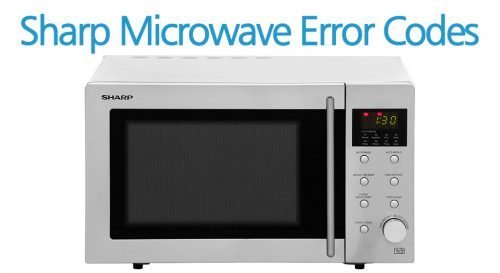
Understanding warranties can sometimes feel like deciphering a secret code of their own, but don’t worry. We’re about to break it down in a way that even a non-techy microwave user can appreciate. A warranty is like a safety net—a promise from the manufacturer that if things go wrong within a certain period, you won’t be left to figure it out (or foot the bill) on your own. Let’s explore how this applies to your Sharp microwave and its mysterious Error Code LE.
Understanding Error Code LE
Before we jump into the coverage, let’s first understand what Error Code LE really means. In the simplest of terms, an error code on a microwave is like a distress signal—it’s your microwave’s way of telling you something isn’t working as it should. Specifically, the LE code often relates to problems with the microwave’s door. It’s as if the microwave is insisting you’ve left the door open or haven’t closed it properly, even if you’re sure it’s shut tight.
So why does this happen? Well, much like a car that won’t start if the doors aren’t securely shut, microwaves have sensors that detect if their doors are completely closed. If these sensors malfunction, even slightly, they can send a false signal, resulting in the infamous LE error. This might be due to wear and tear, dirt affecting the sensors, or even a more serious internal fault. Think of it like trying to get a stubborn drawer to close properly—if something’s blocking it, you might have to jiggle things around or clean it up.
Now, what should you do when faced with this error? The first step is to ensure the door is indeed closed properly. Sometimes a simple gentle push or hearing a click does the trick. If that doesn’t help, it might be time to give the sensors a little clean. But if those efforts are in vain, you might be dealing with a more stubborn issue that requires professional attention. That’s where your warranty could step in.
The Basics of Sharp’s Microwave Warranty
Okay, you’re probably thinking, “Great, I know what the error is—but is it covered?” Sharp, like many manufacturers, offers a warranty on their appliances. Think of it like buying a safety helmet; it’s there to protect you from unforeseen bumps along the road. Typically, Sharp’s warranty covers functional parts of the microwave and defects in material or workmanship for a certain period, usually around one year from the purchase date.
But here’s the catch: warranties often have specific terms and conditions. They generally cover parts like the electronic control board or the magnetron but might exclude certain issues like those arising from misuse or improper handling. So, it’s crucial to read the fine print, much like scanning the terms and conditions before hitting that “I Agree” button online. If your LE error is due to a faulty sensor, there’s a good chance it might be covered. However, if the issue arose from trying to slam the door shut out of frustration, you might be on your own.
To decipher whether your specific issue is covered, you’ll want to locate your proof of purchase—your receipt is the golden ticket here—and check the warranty card that came with your microwave. If you’re anything like most of us, digging through that stack of old receipts might take some time, but it’s a necessary task to ensure your wallet remains unaffected.
Steps to Take if You Encounter Error Code LE
So, now that you’re armed with some knowledge, what’s next? Here’s the game plan if you see that LE code. First, try a basic troubleshooting maneuver: unplug your microwave for a few minutes and then plug it back in. It’s similar to rebooting your computer when it decides to freeze at the most inconvenient times. This resets the microwave and sometimes clears minor glitches.
If the error persists, check your microwave door and inspect the latch. Dust off any gunk that might be hindering sensor connections—like giving your car’s windshield a quick wipe to improve visibility. Next, consult your warranty documentation or the user manual. These often offer specific troubleshooting steps tailored to your model.
Still no luck? It’s time to reach out to Sharp’s customer service. You can call or email them, explaining in detailed yet simple terms what the issue is. Don’t shy away from asking if your problem is covered under warranty—this is like having direct access to the experts who can guide and possibly save you from unexpected expenses.
Preventive Tips to Avoid Error Code LE
Now, we can all agree that preventing a problem is much better than scrambling to fix it later. So, how can you avoid seeing the dreaded Error Code LE in the first place? One of the simplest tips is to handle your microwave door gently—think of it like carefully closing a book without slamming the cover shut. This reduces stress on the door latch and sensors.
Regularly clean the door area and seals to ensure a good connection whenever you close the microwave. A bit of warm soapy water on a cloth can work wonders here, much like maintaining a clean pair of glasses to see clearly. Additionally, periodically check for wear and tear, like you would for a pair of trusty running shoes, replacing anything that looks frayed or out of place.
Finally, if your microwave gives you any sort of hiccup or sign that it’s not working right, address it sooner rather than waiting for a full-on error code. Like handling a minor cold before it turns into the flu, early action can save you time, frustration, and possibly money.
In conclusion, facing an error like LE on your Sharp microwave isn’t the end of the world. With a bit of patience and the right steps, you can determine if it’s covered by your warranty and how to fix it. By understanding, troubleshooting, and maintaining your microwave, you can keep those delicious leftovers deliciously warm without a hitch!